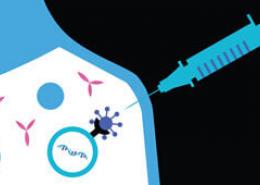MRNA VS. CONVENTIONAL VACCINES

Meet our new Chief Patient Officer, Dr. Dara Richardson-Heron

Working Together to Empower Women

Reducing Health Disparities in Latino Communities

Pfizer Women’s Resource Group

Universal vs. Single Payer Healthcare

Since the COVID-19 pandemic began, the scientific community has come together to work on potential treatments and vaccines. As a part of this effort, newer technologies were explored, including one based on messenger RNA, also known as mRNA, which has now become a key tool in the fight against COVID-19.
mRNA vaccines do not contain any virus particles, meaning that they don’t contain weakened, dead, or noninfectious parts of a virus or bacterium.[i],[ii] They provide instructions that teach our own cells to make part of a virus.[i]
Scientists have identified a coronavirus protein, the spike protein, that the virus uses to attack our cells.[iii] mRNA vaccines provide your body’s cells with instructions for making this protein, without exposing you to the real thing.[iv]
Your immune system then recognizes this antigen as a sign of a foreign invader and summons its defenses, like antibodies and T-cells.[v] The antibodies are specific to the novel coronavirus, SARS-CoV-2, allowing your immune system to store knowledge of how to fight the virus in memory cells.[vi],[vii]According to the Centers for Disease Control and Prevention (CDC), mRNA from a vaccine does not enter the nucleus of a cell. Your body’s cells break down the mRNA instructions after your cells make copies of the spike protein.[ii]
Judith Absalon, Senior Director of Vaccine Clinical Research at Pfizer explained, “You don’t need the actual virus or bacterium to create an mRNA vaccine, instead you only need a small part of its genetic code. Using mRNA technology in this way enabled the efficient development and manufacturing of the vaccine without compromising safety.”
Regulatory authorizations have allowed mRNA vaccines to become one of the key tools in the fight against COVID-19. Millions of people in countries around the world have already received mRNA vaccines against COVID-19.[viii]
These vaccines have been studied in tens of thousands of clinical trial participants, and manufacturers and regulatory bodies will continue to monitor performance, safety, and efficacy of vaccines through a country’s regulatory approval and beyond.
[i] Maruggi G, Zhang C, Li J, Ulmer J, Yu D. mRNA as a transformative technology for vaccine development to control infectious diseases. Mole Ther. 2019;27(4):757-772.
[ii] Understanding mRNA COVID-19 vaccines. CDC. https://www.cdc.gov/coronavirus/2019-ncov/vaccines/different-vaccines/m…. Accessed May 21, 2021.
[iii] Mayo Clinic. COVID-19 vaccines: get the facts. Accessed August 18, 2020. https://www.mayoclinic.org/diseases-conditions/coronavirus/in-depth/cor….
[iv] RNA vaccines: an introduction. PHG Foundation. https://www.phgfoundation.org/briefing/rna-vaccines. Accessed August 18, 2020.
[v] Vaccines and immunization: what is vaccination? WHO. https://www.who.int/news-room/q-a-detail/q-a-on-vaccines. Published August 2019. Accessed August 18, 2020.
[vi] Pardi N, Hogan M, Porter F, Weissman D. mRNA vaccines — a new era in vaccinology. Nat Rev Drug Discov. 2018;17(4):261-279. doi:10.1038/nrd.2017.243
[vii]Understanding how COVID-19 vaccines work. CDC. https://www.cdc.gov/coronavirus/2019-ncov/vaccines/different-vaccines/h…. Accessed January 19, 2021.
[viii] More than 1.57 Billion shots given: Covid-19 Tracker. Bloomberg. https://www.bloomberg.com/graphics/covid-vaccine-tracker-global-distrib…. Published 2021. Accessed May 21, 2021.
PP-CVV-USA-0296 © 2021 Pfizer Inc. All rights reserved. May 2021
Source: Read Full Article
